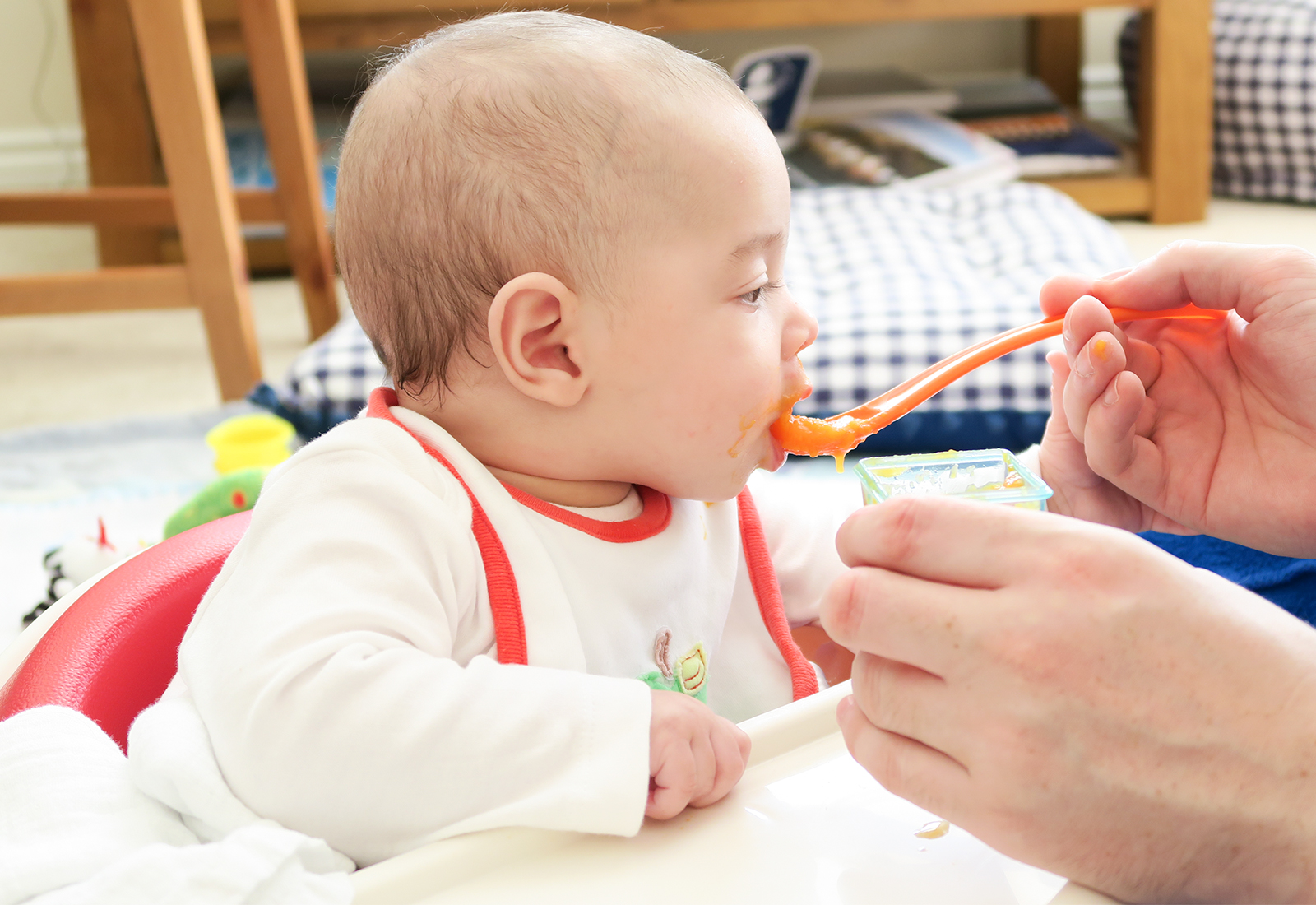
From age four to seven months, the most important changes take place within your child. This is the period when he’ll learn to coordinate his emerging perceptive abilities (the use of senses like vision, touch, and hearing) and his increasing motor abilities to develop skills like grasping, rolling over, sitting up, and possibly even crawling.
Here are some other milestones to look for.
Contents
Baby Development
Lunging—and Maybe Crawling
Sitting becomes a favorite pastime for babies in their seventh month. Most babies can now sit unsupported—although consider keeping those cushions nearby in case she topples!
When your child sees an interesting object out of reach, she may try to get it. Lunging forward from a sitting position is a very important movement. In time, as she continues lunging, she may pivot up onto her knees for an extra long stretch. She’ll learn that she can hold herself up on all fours. She may rock back and forth with this new position, practicing for the next big movement: crawling.
Crawling in itself is not a milestone: Seeing an out-of-reach object and figuring out how to get it is a milestone. Some babies creep on their bellies, some crawl, others scoot on their bottoms. Some babies skip this stage altogether and start pulling up to a stand and walking. But your baby is probably very content right now to sit and observe the interesting sights around her. Enjoy this time, because she will soon be in constant motion.
Stranger Anxiety
Sometime between month six and 12, your baby may show the first signs of being wary of strangers. She can now clearly distinguish between people she knows and people she doesn’t. It is a normal phase and affects children in varying degrees.
You play a very important role in helping her deal with strangers. First, you never have to apologize to anyone for her reactions. Her response is not an indicator of insecurity or a reflection of your parenting skills. Instead, talk to your baby about the stranger: “This is your Uncle Peter. He has heard a lot about you. He looks very happy to meet you.” Your baby will accept the stranger must faster if she can feel your own acceptance. If you like this person, then maybe he is safe.
From the safety of your arms, Baby will watch the stranger’s face and listen to the tone of the conversation between you and the mysterious, new person. Give her the space to become more comfortable. If your baby is more sensitive to strangers, it may not be a good idea to hand her over to the new person to be held. In time, she will warm up and engage the stranger in her own individual way. (Click here to see other social and emotional milestones in Baby’s first year.)
Normal Weight
Growth Patterns
Identifying an ideal weight for a 7-month-old usually means identifying a desirable range. According to KidsHealth, babies come in many different shapes and sizes, and if your baby is in the 5th percentile for weight, that does not mean she is any less healthy than a baby in the 50th or 95th percentile. What is important is that she follow the same pattern of growth. For example, a baby girl who is born in the 50th percentile and jumps up to the 60th percentile at her 1-month well-baby checkup ideally would be around the 60th percentile at following checkups. During the first six months of life, an infant gains about 1.5 to 2 pounds a month, according to KidsHealth. At around 6 months, the weight gain can slow to 1 to 1.25 pounds a month.
Ideal Range
An average 7-pound newborn could weigh about 17 to 18 pounds at the end of the seventh month, according to KidsGrowth. The 50th percentile weight at 7 months is 17 pounds for a girl and 18.5 pounds for a boy.
Games and Activities
Encourage curiosity through playing games. Ideas to help promote motor, sensory, communication and feeding development are listed below.
Motor Games and Activities
- Put a toy or book inside an empty cardboard box. Wrap it with colorful paper or newspaper comics. Clap your hands when baby yanks it open then announce what is inside.
- Encourage movement by placing toys around baby where they must move to reach them
- Encourage baby pushups during Tummy Time by raising and lowering a rattle over baby’s head
- Engage baby in activities like reading or playing with a ball while in sitting
- Gently push baby back and forth on a swing in the park, but make sure baby can sit up and hold head steady with no problem
- When baby is holding a toy in each hand offer a third toy; watch as baby figures out how to grasp the new toy without letting go of the other two
- Punch holes in lid of empty food container and fill with water to make a fun bath time toy
- Get an empty plastic bucket and have baby throw toys into it
- Use different household items , like squeeze toys or newspapers to make different noises for baby
Sensory Games and Activities
- Use your hands to make shadow puppets for baby
- Gently touch baby on the feet and tummy to make them giggle
- Play with a jack in the box or windup toy with baby to show motion
- Use animal sounds when playing with or reading to baby; point out an image of an animal then associate the sound that animal makes with the picture
- Walk with baby in a carrier or baby backpack
- Play with baby in many different positions
- Take baby on a walk in a stroller or jogger
- Use slow, rocking motions for calming and more vigorous motions for play time
- Give baby space to explore environment, while staying close to supervise
- Introduce new textures while baby is eating, sleeping, dressing, or playing outdoors, use a variety of sponges, soaps, and lotions during bath time
- Provide plenty of skin-to-skin contact with a parent or caregiver
- Encourage baby to play on the floor with toys of various colors, sizes, and shapes
- Allow baby to grab and explore items within reach
Communication Games and Activities
- Draw a picture of baby’s face and then point out the different parts
- Play with a pretend phone; talk into phone as you would a regular call, then offer it to baby to do the same
- Read short stories with baby
- Start using hand movements along with associated words to teach baby to communicate with gestures
- Describe your actions throughout the day as you dress, feed, and bathe baby. This gives baby an opportunity to listen to the sounds and rhythms of speech
- Respond to baby’s sounds and encourage two-way communication
- Play music throughout the day – lively, upbeat music during playtime, and quiet melodic music for naps and bedtime
- Read picture books together to help baby connect words and images
- Give baby frequent face time
- Point out objects while you walk and talk with baby
Feeding Games and Activities
- Try introducing pureed foods to baby. Puree a small amount of whatever you are having for dinner in a food processor, but be sure to avoid honey, cow’s milk, salt, and artificial sweeteners
- Introduce new foods gradually and watch for baby’s response
- Do not force food or show stress over a baby’s dislike for certain foods
- Change the texture of food if baby refuses food
- Provide baby with a healthy diet – avoid artificial ingredients, sugars, and preservatives





